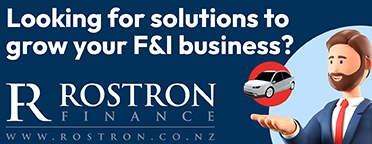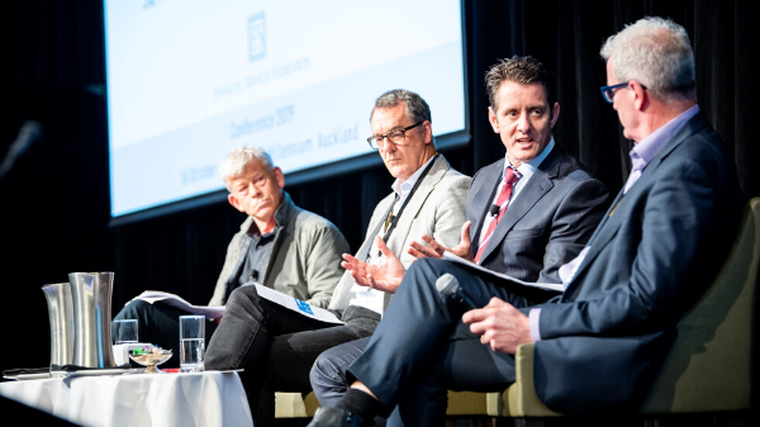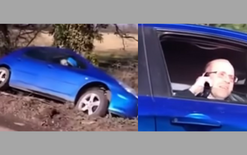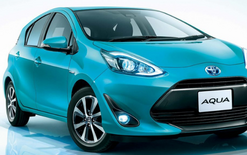Turners, Toyota bosses talk trust
Representatives from three of New Zealand's most trusted brands – according to Reader’s Digest Trusted Brands 2019 – have shared some insight into their companies’ journeys to the accolade, maintaining customer trust and what it means to be have such status.
The panel discussion at the annual conference of the Financial Services Federation (FSF) in Auckland on October 16 featured Andrew Davis, managing director of marketing and business technology at Toyota NZ, Todd Hunter, chief executive officer of Turners Automotive Group, and Mike Durkin, CEO of Resene Paints Ltd. It was facilitated by Mark Mountcastle, CEO of Avanti Finance and chairman of the FSF’s executive committee. What follows are edited highlights from the discussion – you can read more about their talk in Autofile's November magazine.
Mark Mountcastle: Building trust is such an important part of many brand identities and who better to talk about building trust than people who have trusted brands. What’s your point of difference and how is it that Turners has been able to position itself above all packs, so to speak?
Todd Hunter: We’re in a fortunate position where we do have a trusted brand in a market that generally stands to the opposite of that, which is a great place to operate from. Probably, trust is an outcome of a number of things you do. For our business, we’ve been in business – a bit like Resene – for a long time, 52 years. The thing that’s been pervasive throughout the time … is the really strong customer ethic, and generally the business has strong trust attributes and a strong set of values throughout the organisation. Talked about regularly and demonstrated regularly – ultimately your brand has to be a reflection of those values. It has to be a reflection of the way people act, things they read, things they see, experiences they have. So values are so important in terms of how you want that brand to be portrayed and seen.
Mark Mountcastle: Toyota’s a global brand. How does that relationship work in terms of the relationship between the international presence and New Zealand presence? Do you start from the premise of using the international locally or building the local presence to support the international?
Andrew Davis: It’s a cliche, but the “think global, act local” thing certainly applies to us. We've been fortunate in that although we’re a wholly owned subsidiary of Toyota Motor Corporation, we’ve got a good footprint in New Zealand. We’re a long way from Japan and culture is definitely different in different countries, so they leave us to brand locally in our own area. A lot of where the value comes from is where you add value along the way. The way markets are going and people buying up the value chain, so you add value here for your customers and your people on the ground. Our brand is a New Zealand brand. Building the brand takes time, “welcome to our world” for those who remember it back in 1989 and then “everyday people” in ’99. Now we’re in the “Toyota believe” positioning with our marketing. They are all local productions.
Mark Mountcastle: Mike, you have almost personalised the Resene brand. How you think about your brand – it almost sounds like you think of it as a member of the team?
Mike Durkin: Very much so and I take a CFO sort of approach. I’m always battling the marketing manager “you spend too much money”, though. I’m smart enough to keep spending money on our brand, which makes sales stronger, so we’ve got a strong position in our market. Literally everything we do is brand-related. Our innovation and extension of product development is all based on what our customers want, so we don’t just introduce things because we think it’s going to do the job. We have an R&D team of 40-odd people and they drive innovation based on demand. We deliver on what the customer wants. We don’t know what a Resene business person is, but we get the right people on our bus or try to. We don’t really know where the bus is going. Get the right people on the bus and then figure out where to go from there. Get the wrong people on the bus, and they take your brand in the wrong direction.
Mark Mountcastle: It’s interesting using that bus analogy. Todd was talking before about values. There’s clearly a link between your culture and brand. How does that play out in your business?
Todd Hunter: It’s a huge overlap, a hand and glove kind of thing. I’ve been fortunate in the time I’ve been involved in Turners Automotive Group to go through some big changes in positioning the brand, how we were running the company and how the brand needed to reflect that. I’ll give a quick example. Back in sort of 2013 we were very much a wholesale business selling things to dealers, but we wanted to position it to be more retail-focused. One of the big things I wanted to do was actually change the name, which was to drop “Auctions”. That was something – for a lot of people in our business – that was dear to them. Auctions was what Turners did. It was Turners Auctions. I had quite a bit of push-back about that. But it was important to reposition to take advantage of this whole opportunity, and create a strong signal internally as well that we were doing something different. So we made that bold move among other things. One of the big symbols of change was guys used to wear white shirts and ties on the sales floor. To me, that wasn’t what the brand should be. I felt like most people coming in wanted to deal with someone who was more approachable and slightly casual, so we moved to blue-collar shirts and black jeans. Our staff were more identifiable on the floor and felt more comfortable, and our customers felt more comfortable. These are just two small examples when I think culture has a major risk without your brand. You need to have those two things aligned.
Mark Mountcastle: When we think about brand, we often think of the market and customer, so what about the brand internally from the management point of view?
Andrew Davis: We have a brand that has had longevity. When you recruit, people have expectations of what they’re going to experience. Obviously, we’ve got a number of outfits across the country and it’s at the coalface that our brand is represented. So when people buy cars, ultimately it’s that person making engagement that’s representing your brand. A lot of the challenges we have are how, from a national level, we push the energy or values of our brand to our stores, and then how they deliver. What you do when you step back is give yourself time and space to focus on the brand. That makes quite a difference. We spend time deliberating the retail side of our business, but you have to give your brand time to breath. And in doing that, you tend to find you come up with small things you can feed into your stores. It’s an easy conversation or it seems easy.
Mark Mountcastle: From time to time, things don’t go quite according to plan in a business. That must present a challenge in terms of maintaining the trust in the brand. I’m interested what you do in those situations and how you access the right response.
Todd Hunter: With social media now, it’s becoming an even bigger issue for businesses to be in. My philosophy has always been to get on the front foot. If you need to not necessarily defend yourself, bring the context back or to another side to the story. Generally, I’ve found that works pretty well. We had an example earlier this year. I got a text from a director on a Thursday night. He was in Napier and on a local Facebook group. Someone had an experience at our branch there, and had made a comment and people started piling in. I could read it, but couldn’t really do anything about it. It was an interesting position for me because as CEO you’re going, “okay, what should I do about this. Do we let it be and it will die out eventually or...” In the end, what I hope people do in our organisation is use our values to make a decision. To me the right thing was to get on there, find out what happened and put our side across. I requested to get on this Napier site and put a comment on explaining to people, “this is what’s happened, we’ll try to help this lady out”. We explained what will happen and said I've been in contact with her and we were at least hoping for the opportunity to put it right. As soon as something positive came in, I put a comment on and someone liked it. Then it was 120 likes in 15 minutes. They gave us credit saying, “here’s a chance to put it right”. It flipped something that was bad into something that was actually really good. Being a car brand, “recalls” tend to make a lot of people shudder.
The new-vehicle market in New Zealand is 160-odd thousand cars a year and the used-car market’s about the same. We have a lot of customers who obviously have value in our brand themselves that’s basically hidden among social media. The import side has always been a struggle because we have to own issues with cars that have come from Japan that we obviously haven’t sold. So you’re dealing with customers you don’t know because they haven’t purchased from you, but they’ve got issues with their cars so it’s a negative experience from the outset. A lot of our interactions start from a negative perspective. Then it’s how do you put it right. Having those conversations is quite a big thing and social media, as we all know, is a fabulous way for keyboard warriors to get messages across.
Mark Mountcastle: My next question is about how change goes on in the world continuously and how you keep your brand fresh. How do you ensure it is relevant and stays relevant?
Andrew Davis: There are a lot of different things to focus on and we’re going through a transitional phase. We’re seeing the motor industry come to the rise of electrification in some form or other. Our strategy is evolving car brands in the hiring space, but the whole sustainability model with end-of-life vehicles is getting involved, more than just the sudden realisation of cars as something to look at constantly. It’s the right thing to do from a brand perspective. The customer is also demanding that because purchase decisions aren’t just “based on the metal I’m seeing in front of me”, and I don’t think we’ve been doing a bad job around accountability. We’re working a lot in that space. Probably one of the things that’s been interesting is we’re quite a humble brand. Our CEO has been the chairman of Sustainable Business Council for a number of years. That’s a personal choice, but it’s helpful as a brand. A lot of this sort of stuff is coming to the surface, so it’s good to be able to talk about that.
It needs more flexible strategy when you think about where and how your customers’ behaviours are going to change, and how your business is going to reflect that. Keeping your promise is a really important part. You’ve got so many channels, not just TV but platforms, to talk about your brand. You can make a lovely TV ad, but it disappears in a heartbeat if customers aren’t talking the right way about you, so a lot of our focus is in that space. What’s becoming more important is the initial experience of your people, particularly with Google ratings and things like that. That’s becoming so much more important than a great TV ad.
Mark Mountcastle: I was going to ask what the risks of bad ratings are. Anything else that comes top of mind as potential risks to trust in your brand?
Andrew Davis: One of the things for us is making sure you have very good feedback from customers backing your business, so you can sell successfully. And if it’s going wrong, what are you doing about it, making sure you’re fixing it as quickly as you can. I’ve ended up jumping on Facebook and making a comment, then I would never disempower people about having their groups. They should be able to go on and say what they think is right.
Mark Mountcastle: You mentioned sustainability before as something your CEO has chosen as part of his day job, and this sort of highlights the role of the community and participating in a community role. How do you see that going beyond sustainability?
Andrew Davis: Our CEO has been with the company for 40 years and he’s a values-based person. From a marketing view, we support things that support growing New Zealanders’ lives so our partnerships reflect that. The government is getting quite involved in the motor industry particularly around car standards, so finance, supply-side penalties and or rebates. We’ve taken an active position in that we’ve been supporting the government and trying to do something about it, and that sort of thing. You’ve got to take a long-term look at that, so we ensure we’re well-involved in those sort of things.
Mark Mountcastle: You three are here because the market recognises your brands as trusted. If somebody out there was to sit down next to you, what’s the one piece of advice you’d give them as to how to have a trusted brand?
Andrew Davis: The trust in part of a brand is an outcome rather than something you necessarily strive for. For me, it’s working on what’s your tone of voice or what values you’ll be trying to portray. Then work with your staff around how you’re trying to message that from your values position. Ultimately, it’s a trusted brand because your customers have said that. You’ve got to look at that tone of voice, and how you’re reflecting on the tough points and customer experiences.
Todd Hunter: I would say just be super-clear about three things that you want of your organisation for your brand.
Mike Durkin: Reliability, integrity, be clear about your objectives. Ensure your staff are one step behind you, and know where they’re going to and understand what you’re trying to achieve. If you do that and meet customer demand, and you’re nice to them, yourself and everyone else in the organisation, and you’ve got integrity, you can’t go wrong.






